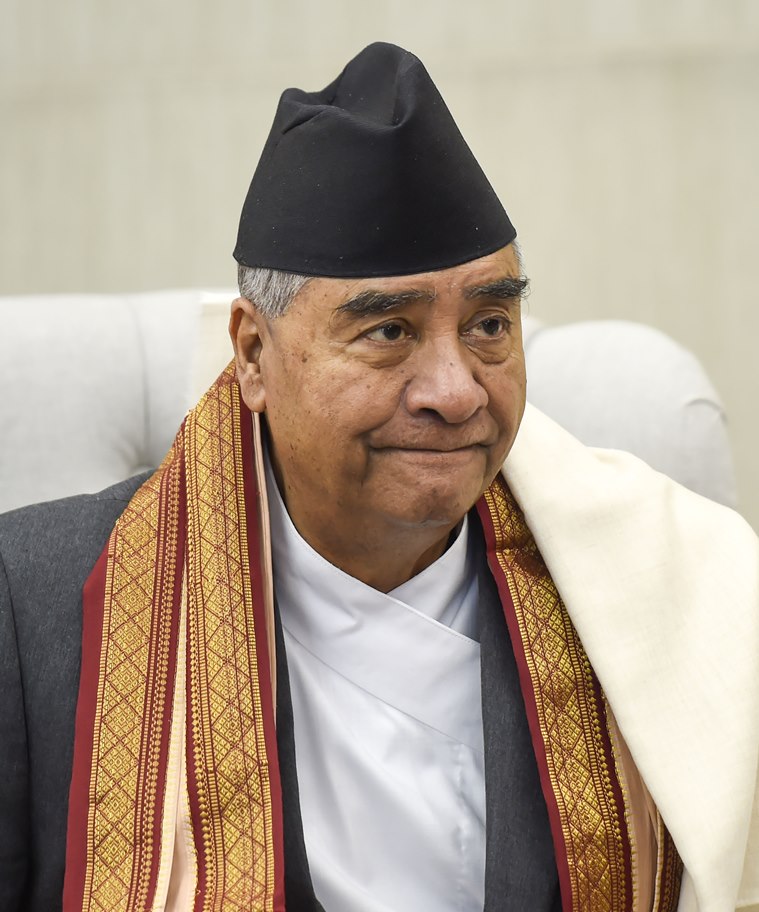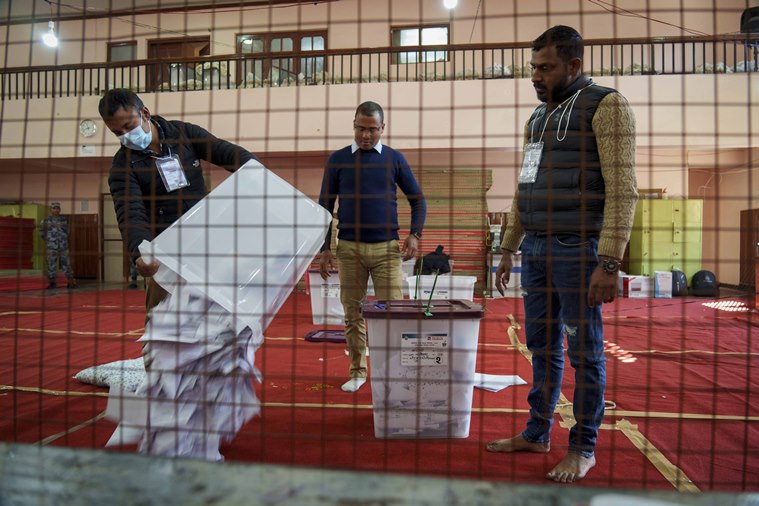Votes are still being tallied in the Nepal parliamentary elections that were held on November 20, only the second since the country adopted its republican constitution in 2015. From the count so far, the six-party pre-poll alliance led by Prime Minister Sher Bahadur Deuba’s Nepali Congress and the Communist Party of Nepal (Maoist Centre) of Pushpa Kamal Dahal ‘Prachanda’ is in the lead.
What Delhi hopes
From India’s perspective, the continuance of a Deuba-led government is the best scenario. The Nepali Congress has old ties to India, and under his prime ministership, India-Nepal ties recovered to a great extent from the low to which they had sunk under Prime Minister K P Oli’s watch.
After succeeding Oli in a game of thrones in 2021, Deuba made his first visit to India in April this year. The three day tour included Varansi, and the Kasi Vishwanath temple and helped to kick start a relationship that had been in the doldrums since the map controversy over Lipulekh in 2020, with Oli seen to be raking it up for political gain back at home.
The Indian establishment views the former prime minister as “pro-China”. Even before Oli began his first term in October 2015 (it lasted until August 2016), India and Nepal had a bitter falling out over Nepal’s new constitution adopted just a month earlier. Delhi was upset that the final draft of the Constitution did not include the marginalisation concerns of the Madhesi and the Tharu — two ethnic groups that live in the southern Terai region along the border with India and constitute 40 per cent of Nepal’s population. Madhesis also have strong cross-border ethnic ties. A blockade of Nepal along the Indian border with tacit support from Delhi crippled supplies to the landlocked country for several months, triggering massive shortages. Oli turned to China for supplies, signing a trade and transit treaty during a visit to Beijing.
When his government was ousted within a year, Oli blamed India. He became prime minister again in 2018 following the 2017 elections after the unification of the Nepal Communist Party (United Marxist Leninist) with Prachanda’s CPN (Maoist Centre). China is believed to have played a key role in the unification. In this second term, India-Nepal relations virtually broke down over the map controversy.
Also, the Chinese envoy to Nepal at the time was seen wielding extraordinary influence on the Oli government, and reportedly worked behind the scenes to ward off a challenge to his leadership from within the party. The two constituents of the NCP eventually split, leading to a chain of events that saw Deuba emerging as the Prime Minister. Following his visit in April this year, Prime Minister Modi visited Lumbini, his fifth visit to Nepal and the first ever by an Indian head of government to the Buddhist holy site, Lord Buddha’s birth place.
Amid discussions on energy co-operation, talk about territory and the call for revising the Indio-Nepal Friendship Treaty quietened.
What Delhi fears
Nothing about the results is a done deal yet. Nepal’s elections are a mix of first past the post for candidates and proportional representation for parties. While the Nepali Congress is ahead of all parties in the number of seats it has won via FTTP, it is behind its alliance partner CPN (MC) in the PR count, under which the party will be allocated additional seats depending on its vote share. Despite being in a pre-poll alliance, Deuba and Prachanda would have to work out a power sharing deal before forming the government.
Should Oli make Prachanda an offer that he cannot refuse, it would be full circle from the point of view of the Indian foreign and security establishment.
There is a middle scenario in which Deuba and Oli could form the government as part of a grand bargain. As the results came out, rumours swirled in Kathmandu that as part of this deal, Deuba’s wife Arooja, said to be politically ambitious herself, could be absorbed in an important position in the government, if Deuba let Oli become PM.

Dark horses
This election was supposed to bring big change in Nepal. That may not happen, as the old parties have still swung enough seats to put them in position for government formation. But several big guns, including ministers and incumbents have been sent packing by voters.
The spectacular debut of the Rashtriya Swatantra Party, appealing to urban youth with its promises of good governance, has been the big story of this election. The party has won six seats, but has garnered 10 per cent of the vote share which will give it more seats in parliament.
In the Madhes region, a new challenger has risen in the form of Janamat Party, led by C K Raut, who once campaigned for the region’s secession. The Madesh vote, earlier held by two parties, is now splintered.
Whatever the shape or colour of the new dispensation, the view from Delhi is that it is bound to be shaky and may not last its term due to the pulls and pressures from within. “The elections have provided a complex, fragmented mandate. Political stability could be elusive,” said Ranjit Rae, who was India’s ambassador to Nepal from 2013 to 2017, and is the author of a recent book on India-Nepal relations, Kathmandu Dilemma – Resetting India-Nepal Ties.
India-Nepal ties post election
For India, the main challenge in Nepal is China’s looming presence. The nature of the India-China contestation in Nepal is different from elsewhere in South Asia. Nepal and India have an open 1800 km -long border. Citizens of both countries can traverse this border freely, to live and work.
But sandwiched between the regional giant and an Asian superpower, Nepal is in the crosshairs of intense geopolitical rivalry. This is not necessarily bad as it gives Nepal enormous leverage with both sides, which it could use to secure the best “deal” for itself. But it also means constant tensions with both neighbours. An alarm is bound to go up in Delhi when China is awarded projects such as the Terai-Madhes Expressway (cancelled by the Nepal Supreme Court earlier this week after Indian bidder Afcons mounted a legal challenge to it), or when China and Nepal discuss railway projects extending to Lumbini, close to the Indian border.
The United States is a recent entrant to the contest, with its interests becoming apparent in the manner in which Deuba’s government managed to find parliamentary support to ratify a long pending but contentious $ 500 million Millennium Challenge Corporation fund hours before it was due to expire. The agreement will finance road building, building, power transmission lines, and facilitate cross-border electricity trade between Nepal and India. The ratification has triggered concern that the “Quad has arrived in Nepal” . US diplomacy in Nepal is now more high profile than it used to be.

For Delhi, this is good news right now, as the US presence is seen as strengthening its hands, but for the long term, if geopolitical alliances shift, and India’s own partnerships evolve, there might be a different view.
Rae pointed out that energy trade has been the “big success story” in India-Nepal relations. During Deuba’s visit, the two sides signed a “vision document” on energy co-operation, agreeing to hydropower generation its “cornerstone”. The elements of this co-operation include joint development of power generation projects in Nepal, development of cross-border transmission infra, bi-directional power trade with appropriate market access on both sides, co-ordination with each other’s national grids, and sharing operational information and technology. They agreed to expand this co-operation to other countries in the Bhutan Bangladesh India Nepal sub-regional grouping
“Speeding up the Pancheshwar project will give a huge boost to the relationship. It will transform the economy not just of Kumaon, but also of western Nepal,” Rae said, referring to the 5,000 mw project on the Mahakali river that has been in limbo for over two decades. “It has huge potential,” he said. During his 2017 visit, Modi visited the site, and the two sides agreed to expedite a detailed project report.





